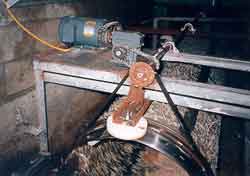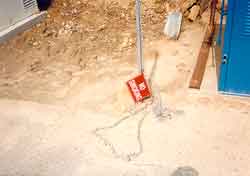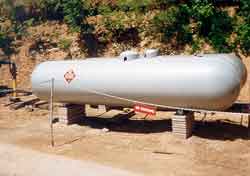





|
Struck by, Struck Against, and Caught In
This
section focuses on the injuries caused by being struck by, struck
against, or caught in machinery. Contributing factors include a
lack of machine guarding and Lockout/Tagout procedures, as well as
failure to follow safety practices for forklifts, trucks, and
storage.
What types of injuries can result from being struck by, struck against,
or caught in machinery?
- Minor
cuts and lacerations;
- Serious
fractures, puncture wounds, amputations; and
- Fatalities.
What steps can an employer take to analyze the worksite for these
types of hazards?
- Determine
existence of forklifts and machinery with moving parts.
- Conduct
a job hazard analysis to evaluate each piece of equipment for
all energy sources.
- Evaluate housekeeping and storage procedures.
Specific contributing factors

Lack of Machine
Guarding
Machine
guarding ranks among the top 10 in numbers of OSHA citations issued.
Why
do machine guarding injuries and fatalities occur?
- Production
Demands
- Employees,
to increase the work pace, often remove machine guards.
This is especially true if employees receive a production
incentive.
- Machine
Design
- New
machinery is often designed with all hazardous moving
parts guarded.
- Older
machinery will often need to be retrofitted with guarding
devices. Machinery that has not been retrofitted exposes
employees to the hazardous moving parts. If the machinery
cannot be retrofitted with a guard, alternate methods
of safe guarding are used, such as light curtains, presence
sensing mats, two-hand controls, and/or guarding by location/distance.
- Machine
Adjustments
- Guards
are often removed to make adjustments to machinery. If
not replaced before operation, employees are exposed to the hazardous area.
- Clearing
Jams
- When
the production line jams, employees often remove or bypass
guards to clear the jam.
- Cleaning
- When
machinery is cleaned, guarding is often removed to ensure
adequate cleaning and sanitation is performed.
- Lack of Management
Commitment
- Production
demands may take precedence over safety.
- Group
or team employee incentives can result in peer
pressure.
- There
may be a lack
of supervision and hazard identification.
- Attention
may not be paid to safety and health.
- Employee
involvement may not be used for:
- Production
line layout, and
- Equipment
purchase.
What can employer and employees do to prevent injuries
from lack of machine guarding?
- Maintain in place guards that are supplied with machinery.
- Retrofit older equipment with appropriate guards.
- Use alternate methods of safeguarding where machine guards
cannot be used.
- Do not remove or defeat guards in order to increase
production rates.
- When it is necessary to remove guards to adjust machines,
clear jams, or perform clearing operations, follow an
established lockout/tagout procedure or otherwise protect
employees.
Employee Training for Machine Guarding
- Employees need to know how machine guards are used, and why they are used.
- Training
should include:
- Identification
and description of the hazards associated with the
machine;
- The
type of guarding (how the guard protects);
- How
to use the guard properly;
- When
the guard can be removed;
- How
the guard is removed;
- Who
is authorized to remove the guard;
- What
do to if a guard is damaged, missing, or does not provide
adequate protection; and
- No
independent actions taken by the employee. If in doubt,
involve supervision.
Lack of Lockout/Tagout (LO/TO) Procedures


Approximately 39 million workers are protected by the Lockout/Tagout rule.
Compliance
with the regulation will prevent about:
- 122
fatalities each year,
- 28,400
lost workday injuries, and
- 31,900
non-lost workday injuries.
What is lockout/tagout?
LO/TO
is used to control all sources of hazardous energy during servicing
and maintenance of machinery.
Energy sources include:
- Mechanical,
- Electrical,
- Hydraulic,
- Pneumatic,
- Chemical, and
- Thermal.
Lockout involves physically locking access to the
control of the energy source to prevent any unexpected energization,
startup, or release of stored energy that could injure a worker.
Each worker must have his own lock.
Tagout
involves placing tags on machinery that is not capable of
being physically locked out to warn employees that serving
or maintenance is being performed. Tags do not provide
the physical restraint of a lock. Lockout is the preferred
method of energy control.
REMEMBER:
There can be multiple energy sources on a single machine.
All sources need to be locked out or tagged.
Adjustments
- Some
servicing and adjustment operations must be performed with
the power on (i.e., fine adjustments, and identifying the
source of a problem). Employees must be protected during these
situations.
- If power is not required during servicing or adjustments, Lockout/Tagout
procedures are required.
- Minor tool changes, adjustments, and/or minor servicing activities
that are routine, repetitive, and integral to the use of production
equipment and that occur during normal production operations
are not covered by the Lockout/Tagout standard.
Equipment Requirements for Lockout/Tagout
- An
adequate number of locks for each employee involved in the
job. If multiple energy sources are present, multiple locks
for each employee will be needed.
- Lockout
hasps for multiple employees needing to lockout a single energy
source.
- An
adequate supply of tags.
Employee
Training for Lockout/Tagout
- All
employees covered by the Lockout/Tagout standard must be trained
on the purpose, function, and restrictions of the energy control
program.
- Employees
performing servicing and adjustments must be able to recognize
all hazardous energy sources and understand the methods of
isolation and control of these energy sources.
- Training
must be done initially when an employee is first covered by
this standard and must reoccur as necessary.
- The
employer must certify that employees have received effective
training. The certification must contain the employee’s name
and the dates of the training.
- Retraining is required when:
- There
is a change in job assignment,
- There
is a change in machines,
- New
equipment that presents a new hazard is introduced to
the workplace,
- There
is a change to a company’s Lockout/Tagout program, and
- The employer has reason to believe there are inadequacies
in the employee’s knowledge of the Lockout/Tagout program.
Failure to Follow Forklift Safety Practices
Forklift safety practices include:
- Elevated Work Locations
- Prohibit employees from standing on forklift forks to
access elevated locations. If a forklift is used as a lift
device for employees, a work platform designed specifically
for this purpose is needed. A back guard is also needed
on the side of the platform nearest the mast frame to prevent
any part of the body from being caught.
- Condition of the Forklift
- Install overhead
guards on forklifts if there is potential
for a load to fall onto the operator.
- General Maintenance
- Inspect all forklifts.
- Equip forklifts with a horn that is clearly
audible over the background noise of the work environment.
The horn is an important warning device to alert employees
working near a forklift of its presence.
- Lights
are needed on forklifts that are used in areas with
inadequate lighting. Lights allow the operator to see
hazards that may make the forklift unstable and to see
persons in the path of the forklift.
- The
brakes of the forklift need to be maintained in excellent
condition. Parking brakes also need to function well
to prevent unexpected movement of the forklift.
- Training
- Train all employees who operate forklifts.
- Training
must be provided annually.
- Make sure the weight of the load never exceeds the
capacity of the forklift.
- Non-Driver
Awareness
- Operators
are not the only employees at risk for forklift related
injury. All employees in the work area must exercise caution
when forklifts are used. All employees need to be aware of
forklifts and respect the dangers by staying out
of the way.
- Standing/Working
under Raised Forks
- Repair
work that must be performed under raised forks must be performed
with caution. A physical block must be placed under the
forks to prevent the forks from dropping and crushing the
employee should the hydraulic system fail.
- When
the forks are elevated, employees should be prohibited from
standing under the area immediately adjacent to the forks
because the forks or objects may fall.
Failure to Follow Truck
Safety Procedures
Truck safety procedures include:
- Caution
must be used around loading docks.
- Employees
need to be aware of delivery trucks in motion. When a truck
is being moved into or out of a loading dock, the driver is
not fully able to see everything behind the vehicle. This can
result in persons being run over by the vehicle’s wheels or
being crushed between a loading dock and the back of the truck.
Having an employee direct the driver while backing up, or using
audio or visual warning devices can warn employees of the potential
hazards.
Failure to Follow Safe Shelving Procedures
Safe shelving and storage procedures include:
- Boxes
- Store heavy
items on lower shelves.
- Do not stack items so high as to be unstable.
- If
shelves are multilevel, there must be appropriate
equipment available to access items stored on higher shelves.
Prohibit employees from climbing storage shelves to access upper
shelves because of the risk of falling. Use Forklifts, ladders,
order pullers, or other methods of accessing high shelves.
- Shelving Units
- Make sure the
capacity of the shelves is clearly indicated on the
shelving units and do not exceed it. Excess weight
can cause the shelves to collapse.
- A
shelving unit system’s vertical supports can be damaged
when hit by forklifts. Damage to the support system can
jeopardize the integrity of the shelving system.
- Secure shelving
units to prevent the units from falling.
Miscellaneous
- Hair
- Long
hair can be a hazard around moving machinery. It can get
caught in moving parts and pull the employee into the hazardous
area. Restrain long hair in a hair net or style it to ensure that it will not get caught in the machinery.
- Jewelry
- Long
dangling jewelry can get caught in the moving parts of machinery
and pull the employee into the hazardous area. Rings can
also get caught on moving parts, so employees must use caution
around machinery if jewelry is worn, or better yet, not
wear it.
- Clothing
- Loose
clothing can get caught in the moving parts of machinery
and pull the employee into the hazardous area. Make sure
loose clothing is not worn around machinery.
- Gloves
- If
hands need to be near the hazardous moving part of a machine,
gloves should not be worn. Gloves can get caught in the
moving parts and pull the employee’s hands and arms into
the machine.
Specific OSHA Requirements
OSHA requirements for the prevention of injuries caused by being struck
by, struck against, or caught in machinery are contained primarily in 29
CFR 1910 Subparts J, N, and O.
Additional explanation of the OSHA requirements for the
control of hazardous energy
can be found in OSHA's
Small
Business Handbook (OSHA Publication 2209-02R). Also available as a 260
KB PDF,
56 pages.
Other useful OSHA publications and documents are:
NOTE: Employers in states with state-run safety and health plans
should check with their state agency. Their state may enforce standards
that, while "as effective as federal standards," may not be
identical to the federal requirements.
Accessibility Assistance:
Contact the OSHA Directorate of Science, Technology and Medicine at 202-693-2300
for assistance accessing OSHA PDF materials.
|

